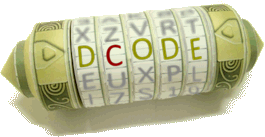Tool to remove diacritics in a text. Diacritics are glyphes added to a letter (circumflex, acute, etc.). They often raise encoding problems with documents.
Diacritics - dCode
Tag(s) : Text Processing
dCode is free and its tools are a valuable help in games, maths, geocaching, puzzles and problems to solve every day!
A suggestion ? a feedback ? a bug ? an idea ? Write to dCode!
Diacritics
Delete diacritics
Answers to Questions (FAQ)
What are diacritics? (Definition)
A diacritic is a graphic element added to a written letter, giving it a variation, usually in its pronunciation or basically to differentiate words.
Example: n, and ñ have a different pronunciation in Spanish
Example: la and là have two different meaning in French (despite an identical pronunciation)
What are the diacritics (that can be deleted)?
Here is a partial list of types of accents and diacritics: acute accent ´, grave accent`, caron ˇ, circumflex/perispomene ˆ, umlaut ¨, point ·, macron ¯, round ˚ or ˳, etc.
dCode is able to identify these elements and remove them. dCode remove accents or other diacritics such as tilde or cedilla and all special characters (non-ASCII, to avoid encoding problems).
Example: dèçodé will be transformed into decode
Variants and combinaisons of these glyphs will also be removed.
What are special characters?
Special characters are the name given improperly to all non-ASCII characters, or not all characters are easily accessible on a keyboard.
How to remove accents in Excel?
Excel does not have such a function. If there is little accents CTRL + H (Search / Replace) is a quick fix. Otherwise, it is possible to create a macro in VBA: // Macro VBA Excel
Function noAccent(str As String) As String Dim withAccent As String, withoutAccent As String, i As Long withAccent = "äâàéèêëïîìöôòüûù" withoutAccent = "aaaeeeeiiiooouuu" For i = 1 To Len(withAccent) str = Replace(str, Mid(withAccent, i, 1), Mid(withoutAccent, i, 1)) Next i noAccent = str End Function
What is the diacritics list in Unicode?
The list of Unicode diacritics is the characters range U+0300 to U+036F.
What are diacritics in English?
The use of diacritics is limited, but there are some acute accent or grave accent, circumflex, diaeresis, a macron, a breve, a umlaut, a cedilla or a tilde.
Source code
dCode retains ownership of the "Diacritics" source code. Any algorithm for the "Diacritics" algorithm, applet or snippet or script (converter, solver, encryption / decryption, encoding / decoding, ciphering / deciphering, breaker, translator), or any "Diacritics" functions (calculate, convert, solve, decrypt / encrypt, decipher / cipher, decode / encode, translate) written in any informatic language (Python, Java, PHP, C#, Javascript, Matlab, etc.) or any database download or API access for "Diacritics" or any other element are not public (except explicit open source licence). Same with the download for offline use on PC, mobile, tablet, iPhone or Android app.
Reminder: dCode is an educational and teaching resource, accessible online for free and for everyone.
Cite dCode
The content of the page "Diacritics" and its results may be freely copied and reused, including for commercial purposes, provided that dCode.fr is cited as the source (Creative Commons CC-BY free distribution license).
Exporting the results is free and can be done simply by clicking on the export icons ⤓ (.csv or .txt format) or ⧉ (copy and paste).
To cite dCode.fr on another website, use the link:
In a scientific article or book, the recommended bibliographic citation is: Diacritics on dCode.fr [online website], retrieved on 2025-10-31,
